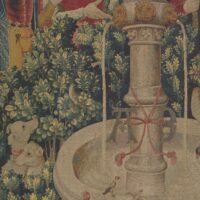![The Unicorn Purifies Water (from the Unicorn Tapestries), 1495-1505, France [Paris]; The Netherlands [Southern Netherlands]. Wool warp with wool, silk, silver, and gilt wefts, overall: 145 x 149 in. (368.3 x 378.5 cm). The Metropolitan Museum of Art, New York, Gift of John D. Rockefeller Jr., 1937 (37.80.2)](http://www.thehistoryblog.com/wp-content/uploads/2020/08/Unicorn-Purifying-Water-200x195.jpg) One the greatest and probably the most famous treasure on display at The Met Cloisters is a series of seven tapestries that depict the mystical hunt of the unicorn. Their early history is unknown and there are enough differences in style, size and composition suggest they made not have been woven as a single set. They were designed in France and woven in the southern Netherlands of wool, silk, silver and gold threads around 1500. The dense florals, rich colors, detailed figures of people and animals have made the Unicorn Tapestries iconic examples of late medieval art.
One the greatest and probably the most famous treasure on display at The Met Cloisters is a series of seven tapestries that depict the mystical hunt of the unicorn. Their early history is unknown and there are enough differences in style, size and composition suggest they made not have been woven as a single set. They were designed in France and woven in the southern Netherlands of wool, silk, silver and gold threads around 1500. The dense florals, rich colors, detailed figures of people and animals have made the Unicorn Tapestries iconic examples of late medieval art.
On each corner of the tapestries and in the center tied to the fountain and foliage with betassled rope are a cipher — A and a backwards E — which are likely a reference to the original owners. The series doesn’t appear on the historical record until 1680 when it was in the Paris mansion of François VI de La Rochefoucauld, the aristocratic writer of maxims. Historians believe the cipher points to the tapestries having been made for Anne of Brittany on the occasion of her wedding to King Louis XII in 1499, her second turn as queen consort of France. The series was acquired from the Counts de La Rochefoucauld by John D. Rockefeller, Jr. in 1923. He loaned it to the Met for exhibitions before donating it to the museum in 1937.
 The Met is still closed and will remain so at least until the end of the month. As part of its Insider Insights webseries, the museum has released an in-depth exploration of the Unicorn Tapestries focusing on one piece in particular: The Unicorn Purifies Water, described as “the most lyrical” of the set.
The Met is still closed and will remain so at least until the end of the month. As part of its Insider Insights webseries, the museum has released an in-depth exploration of the Unicorn Tapestries focusing on one piece in particular: The Unicorn Purifies Water, described as “the most lyrical” of the set.
In this tapestry, 12 hunters and their dogs surround a unicorn on his knees, dipping his horn into a stream of water at the base of a fountain. The foreground and brush are inhabited by a diverse bestiary — a pair of goldfinches and pheasants on the fountain, a pair of lions in the bottom left foreground, a spotted hyena in front of them. The would-be hunters do not approach their quarry here. According to lore, a unicorn cannot be disturbed while performing a magical act. In this case, purifying a poisoned stream, its contamination indicated by the presence of plants used to counter poison in the medieval pharmacopia, and because “unicorn horn” (ie, rhinoceros or narwhal horn) was considered a universal antidote.
The Cloisters research assistant Amelia Roche’ Hyde ties the visual iconography of the tapestry to its historical context and explains the dense layers of symbolism woven in with the gold and silver threads.
M’Lady Livius,
Thank you for presenting this marvelous story and video. There is so much to learn from watching the presentation.
The Met video does not mention that there is another set of these tapestries in Scotland’s Stirling Castle. King James V was known to have owned a set of these hangings, now sadly lost. Several years ago a replacement set based on the Met’s tapestries was commissioned. They are now on display within the castle. The weaving shop is a very interesting museum-within-a-museum, explaining how the modern set was created. The Stirling Castle web pages include a section devoted to the hangings: https://www.stirlingcastle.scot/discover/highlights/the-stirling-tapestries/ .
My Lady Sarah Sinclair and I were able to view the recreated tapestries on a visit to Stirling Castle in 2017. I must say that I was more interested in the Stirling Heads, Mary of Guise’s golf clubs and the costumes of various docents, but did find the hangings impressive. If we ever return, I will give the hangings closer study.
More on the Unicorn tapestries is found on Wikipedia at https://en.wikipedia.org/wiki/The_Hunt_of_the_Unicorn
Yours Aye,
Mungo Napier, Laird of Mallard Lodge 🦆 (SCA)
(aka Garth Groff)
Let us not forget that –at least currently– the “Southern Netherlands” are referred to as “Belgium”, and indeed that tapestry appears to look like the ones that they have over there in Brussels.
The artist, however, otherwise known as the “Maître de la Chasse New Yorkaise à la Licorne”, completed this series of seven because they were put onto early modern living room walls, and people tended to have more than one wall.
Of course, the “AƎ” emblem is interesting, but I also like particularly the “hunting duck” in the left hand corner, and also the cheetah, the lions and what appears to be an ermine and a kolibri. The AƎ -who knows?- might be Alpha and Omega, or ‘A’ and ‘ω’.
:hattip:
—————
PS- There is some sort of letters on the red sword sheath and also a little face on the rim of that fountain.